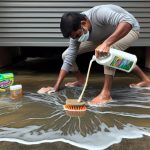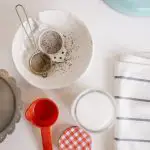Are you tired of stubborn stains ruining your favorite clothes? Look no further! In this article, we’ve compiled the 6 best techniques for removing fabric stains.
From pre-treating with stain remover to harnessing the power of baking soda, we’ve got you covered. Say goodbye to those pesky stains and hello to fresh, clean clothes again.
So grab your stain-fighting arsenal and get ready to tackle those tough stains head-on!
Table of Contents
Pre-Treating With Stain Remover
First, grab a stain remover and apply it directly to the fabric stain.
Stains on your favorite clothes can be a real headache, but with the right techniques, you can easily eliminate them.
Hot water treatment is one effective method to remove stubborn stains. After applying the stain remover, fill a bucket with hot water and soak the stained fabric for about 30 minutes. The heat helps to loosen the stain, making it easier to remove.
Steam cleaning techniques are also highly recommended for pre-treating fabric stains. If you have a garment steamer at home, you’re in luck. Simply direct the steam towards the stained area, focusing on the spot for a few seconds. This will help break down the stain and lift it from the fabric fibers.
Remember, when using hot water or steam, always check the fabric care label to ensure that it can withstand these treatments. Some delicate fabrics may be susceptible to damage from high temperatures. Additionally, be sure to test the stain remover on a small, inconspicuous area of the fabric before applying it to the stain. This will help prevent any potential discoloration or damage.
With the right pre-treating techniques, you can tackle fabric stains with confidence and restore your garments to their former glory.
Using White Vinegar for Stubborn Stains
To effectively tackle stubborn fabric stains, you can use white vinegar as a powerful solution. Here are four reasons why using vinegar for stain removal is a smart choice:
-
It’s a natural and non-toxic option: Unlike harsh chemical stain removers, vinegar is a safe and eco-friendly alternative. It won’t harm your skin or the environment.
-
It’s versatile: Vinegar can be used on a wide range of fabrics, from cotton to silk. Whether you’re dealing with coffee, wine, or grass stains, vinegar can help break down the stubborn marks.
-
It’s cost-effective: White vinegar is inexpensive and readily available in most households. By using vinegar for stain removal, you can save money on expensive commercial stain removers.
-
It doubles as a natural fabric softener: Not only does vinegar remove stains, but it also acts as a natural fabric softener. Add a cup of vinegar to your laundry cycle to make your clothes feel extra soft and fresh.
Blotting and Dabbing With Hydrogen Peroxide
You can effectively remove fabric stains by blotting and dabbing with hydrogen peroxide. Hydrogen peroxide is a popular and effective stain remover that can be found in most households. However, if you don’t have hydrogen peroxide on hand or prefer to use alternative fabric stain removal methods, there are a few options you can try.
One alternative to hydrogen peroxide is using lemon juice. Lemon juice is a natural bleaching agent and can help remove stains from fabrics. Simply squeeze fresh lemon juice onto the stain and let it sit for a few minutes before blotting it away with a clean cloth.
Another alternative is using baking soda. Baking soda is great for removing tough stains and odors. Mix a small amount of baking soda with water to create a paste and apply it to the stain. Gently rub the paste into the fabric and let it sit for a few minutes before rinsing it off.
Lastly, you can try using white vinegar as an alternative to hydrogen peroxide. White vinegar is a versatile cleaning agent that can help remove stains and odors. Mix equal parts white vinegar and water and apply it to the stain. Let it sit for a few minutes before blotting it away with a clean cloth.
Harnessing the Power of Baking Soda
To harness the power of baking soda in removing fabric stains, mix a small amount with water to create a paste and apply it to the stain. Baking soda isn’t just a pantry staple; it’s also a powerful cleaning agent with a multitude of benefits.
Here are four alternative uses for baking soda that make it a must-have in your cleaning arsenal:
-
Odor Eliminator: Baking soda is known for its ability to absorb and neutralize odors. Sprinkle it on fabrics or carpets, let it sit for a while, and then vacuum it up to eliminate unwanted smells.
-
Stain Remover: As a mild abrasive, baking soda can effectively remove tough stains from fabrics. Its gentle nature makes it suitable for use on delicate materials without causing damage.
-
Whitening Agent: Baking soda can brighten and whiten fabrics. Add a cup of baking soda to your laundry cycle to enhance the cleaning power of your detergent and achieve brighter, fresher-looking clothes.
-
Carpet Freshener: Sprinkle baking soda on your carpets before vacuuming to freshen them up. It won’t only eliminate odors but also absorb any moisture, leaving your carpets clean and refreshed.
Applying Dish Soap for Grease and Oil Stains
For more effective removal of grease and oil stains, regularly apply dish soap to the affected fabric. Dish soap isn’t only great for tackling greasy and oily stains, but it can also be used for other types of stains, such as food or beverage stains.
When using dish soap to treat fabric stains, it’s important to pre-treat the stain before applying the soap. There are different methods you can try to pre-treat the stain, depending on the type of fabric and the severity of the stain.
One method is to blot the stain with a clean cloth or paper towel to remove any excess grease or oil. Then, apply a small amount of dish soap directly to the stain and gently rub it in using a soft-bristled brush or your fingers. Allow the soap to sit on the stain for a few minutes to penetrate the fabric.
Another method is to create a mixture of dish soap and water. Mix a few drops of dish soap with warm water to create a soapy solution. Apply the solution to the stain and let it sit for a few minutes. Then, gently scrub the stain with a brush or cloth. Rinse the fabric with clean water to remove any soap residue.
After pre-treating the stain, you can proceed to wash the fabric as usual. Remember to check the care label on the fabric for any specific washing instructions. By regularly applying dish soap and pre-treating the stains, you can effectively remove grease and oil stains from your fabrics.
Trying the Age-Old Remedy of Lemon Juice and Sunlight
To enhance the effectiveness of stain removal and build upon the previous method, consider harnessing the power of a timeless remedy – lemon juice and sunlight. This age-old technique has proven to be highly effective in removing stubborn stains from fabric. Here are four reasons why lemon juice and sunlight should be your go-to stain removal solution:
-
Lemon juice effectiveness:
Lemon juice is a natural bleaching agent that can effectively lighten and remove stains from fabric. Its high acidity helps break down tough stains and remove discoloration. -
Sunlight exposure benefits:
When combined with lemon juice, sunlight acts as a natural stain remover. The UV rays from the sun work together with the lemon juice to break down and fade the stain, leaving your fabric looking fresh and clean. -
Easy and affordable:
Lemon juice is readily available in most households, making it a convenient and cost-effective stain removal solution. Additionally, sunlight is a free resource that can be easily accessed by simply placing your stained fabric in direct sunlight. -
Environmentally friendly:
Lemon juice and sunlight offer a natural and eco-friendly alternative to harsh chemical stain removers. By utilizing these ingredients, you can effectively remove stains while minimizing your impact on the environment.
Frequently Asked Questions
Can I Use These Stain Removal Techniques on Delicate Fabrics?
Yes, you can use these stain removal techniques on delicate fabrics. However, it’s important to take precautions. Test the technique on a small, inconspicuous area first and use gentle motions to avoid damaging the fabric.
How Long Should I Let the Stain Remover Sit Before Washing the Fabric?
For best stain remover effectiveness, it’s recommended to let it sit on the fabric for a while before washing. This wait time allows the stain remover to penetrate and break down the stain more effectively.
Can I Use White Vinegar on Colored Fabrics Without Causing Any Discoloration?
Yes, you can use white vinegar as a fabric stain remover on colored fabrics without causing any discoloration. It is a natural and effective alternative method for removing stains from colored fabrics.
Is It Safe to Mix Hydrogen Peroxide With Other Cleaning Agents?
Mixing hydrogen peroxide with bleach is risky and should be avoided. As a standalone fabric stain remover, hydrogen peroxide is effective, but it has limitations. It’s important to use it properly to prevent any damage to your fabrics.
Can I Use Baking Soda on All Types of Fabric, Including Silk and Wool?
Yes, you can use baking soda on all types of fabric, including silk and wool. However, there are potential risks such as discoloration or damage. It’s safer to try alternatives like gentle detergents or seeking professional cleaning for delicate fabrics.
- Tetron Fabric for Marine Applications: Durability and Use Cases - June 18, 2025
- Tetron Fabric for Outdoor Furniture: Weather Resistance and Care - June 18, 2025
- Tetron Fabric for Wall Coverings: Style and Application Tips - June 18, 2025




